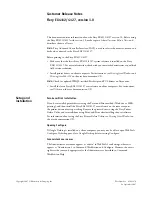
118
D14049.05
February 2009
Grey Headline
(continued)
TANDBERG
VIDEO COMMUNICATIONS SERVER
ADMINISTRATOR GUIDE
Introduction
Getting started
Overview and
status
System
configuration
VCS
configuration
Zones and
neighbors
Call
processing
Bandwidth
control
Firewall
traversal
Appendices
Applications
Maintenance
Call IDs, Serial Numbers and Tags
Identifying a particular call
Identifying calls in the CLI
To control a call using the CLI, you must reference the call using either its Call ID or Call Serial
Number. These can be obtained using the command:
xStatus Call
•
s
This will return details of each call currently in progress in order of their Call ID. The second line of
each entry will list the Call Serial Number, and the third will list the Call Tag.
Call ID
Call serial number
Each call that passes through the VCS is assigned a Call ID and a Call Serial Number. Calls also
have a Call Tag assigned if this does not already exist.
Call ID
The VCS assigns each call currently in progress a different Call ID. The Call ID numbers start at 1
and go up to the maximum number of calls allowed on that system.
Each time a call is made, the VCS will assign that call the lowest available Call ID number. For
example, if there is already a call in progress with a Call ID of 1, the next call will be assigned a
Call ID of 2. If Call 1 is then disconnected, the third call to be made will be assigned a Call ID of 1.
The Call ID is not therefore a unique identifier: while no two calls in progress at the same time will
have the same Call ID, the same Call ID will be assigned to more than one call over time.
Call Serial Number
The VCS assigns a unique Call Serial Number to every call passing through it. No two calls on a
VCS will ever have the same Call Serial Number. A single call passing between two or more VCSs
will be identified by a different Call Serial Number on each system.
Call Tag
Call Tags are used to track calls passing through a number of VCSs. When the VCS receives a call,
it checks to see if there is a Call Tag already assigned to it. If so, the VCS will use the existing
Call Tag; if not, it will assign a new Call Tag to the call. This Call Tag is then included in the call’s
details when the call is forwarded on. A single call passing between two or more VCSs will be
assigned a different Call Serial Number each time it arrives at a VCS (including one it has already
passed through) but can be identified as the same call by use of the Call Tag. This is particularly
useful if you are using a
remote syslog server
to collate events across a number of VCSs in your
network.
The Call Tag also helps identify loops in your network - it is used as part of the automatic
Call loop
detection
feature, and you can also search the Event Log for all events relating to a single call tag.
Loops occur when a query is sent to a neighbor zone and passes through one or more systems
before being routed back to the original VCS. In this situation the outgoing and incoming query will
have different Call Serial Numbers and may even be for different destination aliases (depending on
whether any transforms were applied). However, the call will still have the same Call Tag.
Call Tags are supported by VCS version X3.0 and above. If a call passes through a system
that is not a VCS, or a VCS that is running an earlier version of the software, the Call Tag
information will be lost.
Call tag
Identifying calls in the web interface
The
Call summary
,
Call details
and
Search details
pages shows the Call Tag. The
Call details
and
Search details
pages also show the Call Serial Number.
The VCS web interface does not use the Call ID.
















































